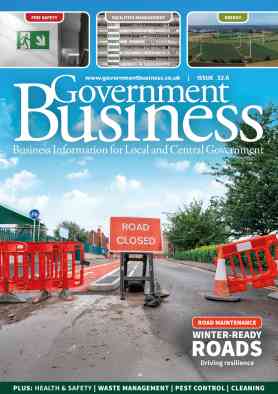
Fire safety in the public sector
Fire safety is a legal and moral duty for public bodies, with compliance essential across schools, hospitals, council buildings, and other community assets. In this feature, Alex Aiston MIFSM of AFC Fire, writing on behalf of the Institute of Fire Safety Managers, outlines the responsibilities, risks, and best practice strategies that underpin effective fire safety management in the public sector.
In the wake of high-profile fire safety failures across the UK, public sector organisations are under growing scrutiny to demonstrate robust compliance. Schools, hospitals, council buildings, government offices, and other public assets serve not just as workplaces but as vital community spaces – meaning the consequences of non-compliance can be severe, both in terms of public safety and organisational reputation.
While compliance has always been a legal necessity, the shift in public awareness and regulatory focus in recent years has made it clear: in the public sector, fire safety is not merely a box-ticking exercise. It’s a continuous, proactive duty.
“Compliance is not a one-time achievement – it’s an ongoing process.” – Hood Builder Magazine, 2024.
The legal landscape
The cornerstone of UK fire safety in non-domestic premises is the Regulatory Reform (Fire Safety) Order 2005 (FSO), which consolidates various earlier laws into a single, risk-based framework. Under the FSO, the “responsible person” – often the employer, building owner, or managing authority – must carry out a suitable and sufficient fire risk assessment and act upon its findings.
In the public sector, this duty can apply to local authorities, NHS Trusts, central government departments, and other statutory bodies. They are required not only to meet
the baseline standards but to ensure compliance is sustained through regular reviews, staff training, and maintenance of
fire safety systems.
Fire safety enforcement in most public buildings falls under local Fire and Rescue Authorities, but other bodies – such as the Health and Safety Executive (HSE) – can become involved depending on the nature of the premises or activities.
Who holds the responsibility?
Maintaining high compliance standards in the fire safety sector relies on the combined efforts of both public and professional bodies. Key organisations, such as the HSE and local authorities, together with professional bodies such as the Institute of Fire Safety Managers (IFSM) all contribute to ensuring consistent safety and regulatory oversight.
HSE: While primarily known for enforcing health and safety in workplaces like construction sites and factories, the Health and Safety Executive also has a role in certain fire safety contexts, especially where worker safety overlaps with public safety. Its guidance often informs risk assessment methodology and safety management systems in public bodies.
Local Government Authorities: Councils are in a unique position, they are both duty holders for the buildings they own and managers of local enforcement through Fire and Rescue Services. This dual role requires them to set an example in compliance while holding others to the same standard.
Professional Bodies: While not regulators, professional bodies set important benchmarks for individuals and organisations working in fire safety. Members of bodies such as the Institute of Fire Safety Managers (IFSM), the Institution of Fire Engineers (IFE), and others must meet recognised qualification standards and commit to continuous professional development (CPD). When commissioning fire risk assessments, public bodies can refer to the registers of fire risk assessors maintained by these organisations as a means of verifying competency. The IFSM, for example, operates a tiered register that recognises varying levels of competency aligned to the complexity of different building types.
Maintaining competence
Fire safety compliance depends heavily on the competence of those carrying out fire risk assessments. Public bodies are increasingly expected to ensure their appointed assessors are appropriately qualified, whether through IFSM, IFE, or equivalent schemes.
Competence is not static – regulations evolve, building uses change, and new hazards emerge. A one-off qualification obtained years ago is not enough; ongoing CPD, refresher training, and awareness of emerging risks are essential.
Common compliance challenges
Despite clear legal frameworks, public sector organisations face recurring issues.
Risk assessments are often outdated, having not been reviewed for several years, and may no longer reflect the current building use or layout. In some cases, assessments are carried out by unaccredited individuals, resulting in incomplete or inaccurate evaluations. Limited budgets can also delay necessary remedial works, which increases both risk and potential liability. Additionally, governance can become inconsistent when multiple sites are managed across different departments, leading to fragmented oversight.
Case Study: Regulatory Action at Harlow Council
In late 2024, the Regulator of Social Housing published a damning regulatory judgment on Harlow District Council, revealing serious failings in fire safety compliance. The council had conducted fire risk assessments for only around 20 per cent of the 9,100 homes requiring them and had more than 500 high-risk and 1,500 medium-risk fire safety actions outstanding – many overdue for more than 12 months.
As a result, the council was issued a C3 grading, signalling significant consumer standard failures and an urgent need for remedial action. The Regulator emphasised that these deficiencies placed residents at risk and represented a breach of the Home Standard.
Following the judgment, Harlow Council committed to an intensive action plan, including bringing all fire risk assessments up to date, prioritising high-risk actions, and adopting recognised assessor competency frameworks such as those endorsed by the Institute of Fire Safety Managers (IFSM) and the Institution of Fire Engineers (IFE). The case highlights the regulatory expectation that public bodies maintain not only compliance on paper but active, ongoing fire safety management.
The governance factor
Public sector compliance is not just a facilities management issue – it is a governance issue. Boards, senior management teams, and councillors all carry a measure of accountability. Documented evidence of assessor competence, a clear audit trail for remedial works, and scheduled review dates are all governance essentials.
Strong governance frameworks integrate fire safety compliance into wider risk management strategies. For example, many public bodies now require quarterly compliance reports to be presented at board level, ensuring that fire safety is given the same attention as finance or safeguarding.
Enforcement and consequences
Non-compliance can lead to serious consequences. Legal penalties may include substantial fines or, in extreme cases, imprisonment for severe breaches. Fire and Rescue Authorities can issue enforcement notices, requiring immediate corrective action. Reputational damage is also a significant risk, as media exposure can erode public trust –particularly when vulnerable service users are affected.
The Harlow Council example demonstrates that regulators will take decisive action where systemic failings are identified – and that remedial action must be both swift and sustainable.
Best practice in the public sector
Successful compliance strategies tend to follow a few key principles. Risk assessments should be reviewed regularly – at least once a year, or sooner if there are significant changes to the building or how it’s used. Assessors must be properly qualified, ideally holding credentials from the Institute of Fire Safety Managers (IFSM) or the Institution of Fire Engineers (IFE). Clear accountability is essential, with named individuals at a senior level responsible for oversight. Finally, all reporting should be transparent, with accessible records of both risk assessments and any remedial actions taken.
A continuous commitment
The most effective public bodies treat fire safety as a continuous process, not a sporadic activity. This means embedding it into day-to-day operations, from procurement to HR, and ensuring that fire risk is always on the organisational agenda.
In the words of one senior fire safety consultant: “Compliance is not a one-time achievement – it’s an ongoing process.” Hood Builder Magazine, 2024.


